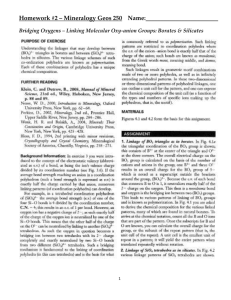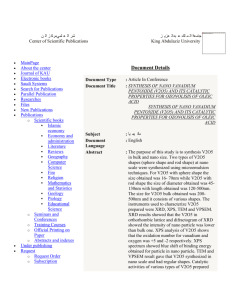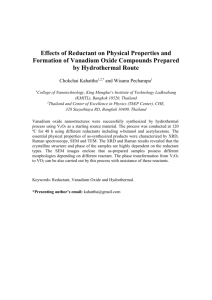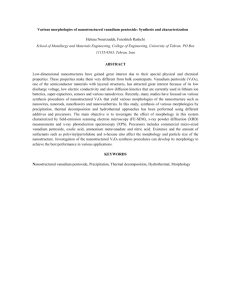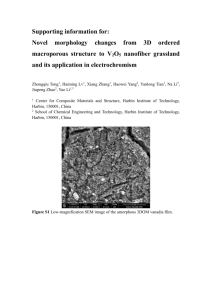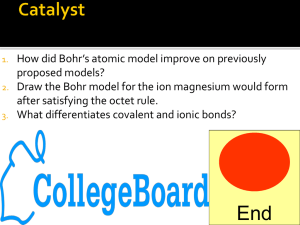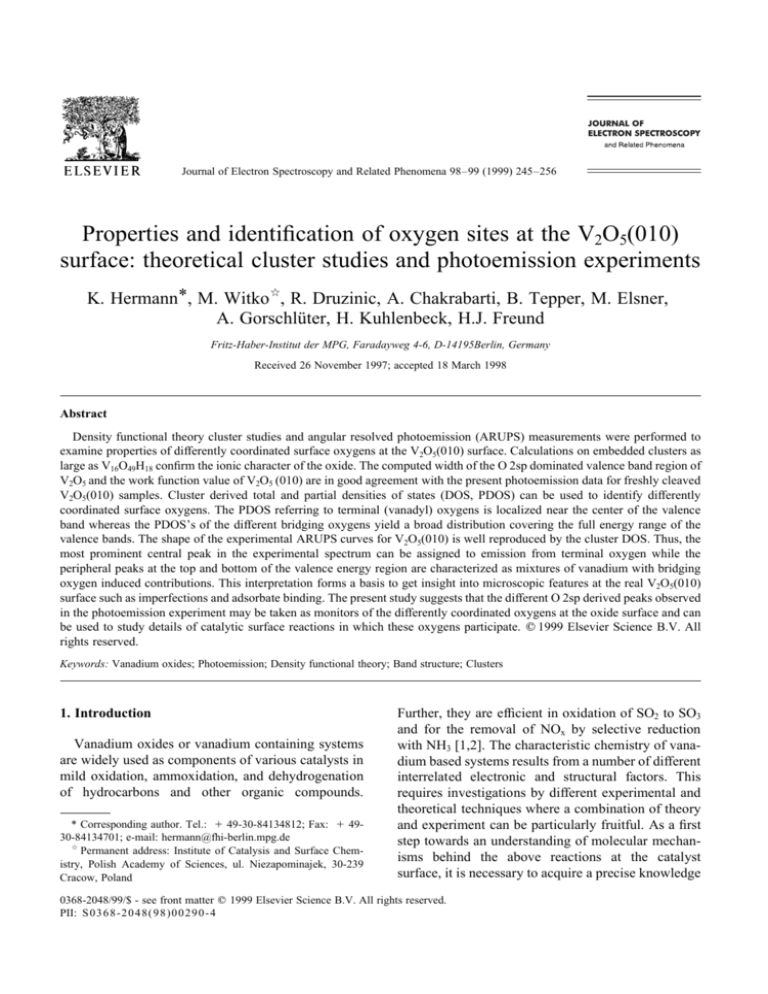
Journal of Electron Spectroscopy and Related Phenomena 98–99 (1999) 245–256
Properties and identification of oxygen sites at the V2O5(010)
surface: theoretical cluster studies and photoemission experiments
K. Hermann*, M. Witko 夽, R. Druzinic, A. Chakrabarti, B. Tepper, M. Elsner,
A. Gorschlüter, H. Kuhlenbeck, H.J. Freund
Fritz-Haber-Institut der MPG, Faradayweg 4-6, D-14195Berlin, Germany
Received 26 November 1997; accepted 18 March 1998
Abstract
Density functional theory cluster studies and angular resolved photoemission (ARUPS) measurements were performed to
examine properties of differently coordinated surface oxygens at the V2O5(010) surface. Calculations on embedded clusters as
large as V16O49H18 confirm the ionic character of the oxide. The computed width of the O 2sp dominated valence band region of
V2O5 and the work function value of V2O5 (010) are in good agreement with the present photoemission data for freshly cleaved
V2O5(010) samples. Cluster derived total and partial densities of states (DOS, PDOS) can be used to identify differently
coordinated surface oxygens. The PDOS referring to terminal (vanadyl) oxygens is localized near the center of the valence
band whereas the PDOS’s of the different bridging oxygens yield a broad distribution covering the full energy range of the
valence bands. The shape of the experimental ARUPS curves for V2O5(010) is well reproduced by the cluster DOS. Thus, the
most prominent central peak in the experimental spectrum can be assigned to emission from terminal oxygen while the
peripheral peaks at the top and bottom of the valence energy region are characterized as mixtures of vanadium with bridging
oxygen induced contributions. This interpretation forms a basis to get insight into microscopic features at the real V2O5(010)
surface such as imperfections and adsorbate binding. The present study suggests that the different O 2sp derived peaks observed
in the photoemission experiment may be taken as monitors of the differently coordinated oxygens at the oxide surface and can
be used to study details of catalytic surface reactions in which these oxygens participate. 䉷 1999 Elsevier Science B.V. All
rights reserved.
Keywords: Vanadium oxides; Photoemission; Density functional theory; Band structure; Clusters
1. Introduction
Vanadium oxides or vanadium containing systems
are widely used as components of various catalysts in
mild oxidation, ammoxidation, and dehydrogenation
of hydrocarbons and other organic compounds.
* Corresponding author. Tel.: ⫹ 49-30-84134812; Fax: ⫹ 4930-84134701; e-mail: hermann@fhi-berlin.mpg.de
夽
Permanent address: Institute of Catalysis and Surface Chemistry, Polish Academy of Sciences, ul. Niezapominajek, 30-239
Cracow, Poland
Further, they are efficient in oxidation of SO2 to SO3
and for the removal of NOx by selective reduction
with NH3 [1,2]. The characteristic chemistry of vanadium based systems results from a number of different
interrelated electronic and structural factors. This
requires investigations by different experimental and
theoretical techniques where a combination of theory
and experiment can be particularly fruitful. As a first
step towards an understanding of molecular mechanisms behind the above reactions at the catalyst
surface, it is necessary to acquire a precise knowledge
0368-2048/99/$ - see front matter 䉷 1999 Elsevier Science B.V. All rights reserved.
PII: S0368-204 8(98)00290-4
246
K. Hermann et al. / Journal of Electron Spectroscopy and Related Phenomena 98–99 (1999) 245–256
of the geometrical and electronic surface structure
itself. The crystal structure of divanadium pentoxide,
V2O5, is rather complex and can be described in
different ways. The orthorhombic crystal has a layer
structure in which each layer consists of VO5 subunits linked by edges (forming zig-zag rows) and by
corners [3–5] with weak inter-layer coupling. The
basal (010) and other non-basal planes differ in their
bond type and in the degree of coordinative saturation
of vanadium and oxygen atoms. This results in
different behavior with respect to adsorption and catalytically supported reactions.
It is generally accepted that reactions of selective
hydrocarbon oxidation at the catalytically active
V2O5(010) surface proceed according to a redox
mechanism where the hydrocarbon molecule loses
one or two hydrogens and incorporates oxygen
which originates from active sites of the oxide surface
[1,2,6–8]. This process forms oxygen vacancies at the
surface which may migrate into the bulk with the
equivalent number of metal cations being simultaneously reduced. Gaseous oxygen participates in the
oxidation reaction only after adsorption in other parts
of the catalyst followed by migration through the
lattice to the active site. The key point for understanding the mechanisms of selective hydrocarbon
oxidation is to identify those structurally different
surface oxygens which play the most important role
in the reaction, i.e. which are responsible for abstraction of hydrogen(s) and which are inserted into the
organic species yielding the oxygenated product.
This issue has been discussed rather controversially
in the literature. Some authors assume that terminal
vanadyl oxygen (OyV) is removed from the catalyst
surface to form a lattice vacancy [1] while others
argue in favor of bridging oxygens (V–O–V or V–
O–Me in the case of supported vanadia catalysts) and
there are reports suggesting that a mixture of VyO
and V–O–V(Me) type oxygens is essential for the
selective oxidation process. However, the underlying
mechanisms have not been verified by experiments on
a microscopic basis, for an overview see Ref. [1].
Previous theoretical cluster studied using semiempirical [8–15] and ab initio methods (Hartree–Fock
(HF) [16–18] and density functional theory (DFT)
[19–21]) have shown consistently that two- and
three-fold coordinated bridging oxygens can be
removed more easily from the V2O5(010) surface
than vanadyl oxygens. This result is confirmed by
combined numerical (semiempirical HF) and experimental (IR) studies [22] on the importance of V2O5
surface oxygen for the oxidation of SO2 into SO3
which stress the preference of oxygen centers with
the highest V coordination. Altogether, there is no
experimental technique so far which can yield reliable
microscopic information on the participation of differently coordinated surface oxygens in reactions at the
V2O5 surface. This is also connected with the fact that
a direct experimental identification of the different
surface oxygens is very difficult if not impossible.
Indirect information may be obtained from experimental techniques that probe the local electronic
structure of surface oxygens since differently coordinated (and charged) oxygens are expected to result in
different local electronic environments. In the present
work we propose a combination of electronic structure calculations, based on cluster and periodic
approaches, with experimental valence photoemission
spectroscopy (ARUPS) to examine the O 2sp derived
valence electron structure at the V2O5(010) surface.
The theoretical results are consistent with experiment
and suggest that the differently coordinated surface
oxygens (terminal vanadyl oxygens, O(1), two- and
three-fold coordinated bridging oxygens, O(2)/O(3))
make distinctly different contributions to the O 2sp
valence density of states at the V2O5(010) surface.
These contributions can be observed in the photoemission spectrum thus allowing an identification of
the terminal and bridging surface oxygens by experiment. Therefore, changes in the photoemission spectrum induced by catalytically activated surface
reactions may give information on the participation
of differently coordinated surface oxygens.
In Section 2 we outline briefly the technical details
of the theoretical and experimental methods used in
the present work, while in Section 3 we present results
and discussion. Finally, Section 4 summarizes our
conclusions.
2. Technical details
2.1. Theoretical details
Divanadium pentoxide, V2O5, is characterized as a
bulk material by a layer type orthorhombic structure
K. Hermann et al. / Journal of Electron Spectroscopy and Related Phenomena 98–99 (1999) 245–256
Fig. 1. Crystal structure of orthorhombic V2O5 with netplane
stacking along (010). Vanadium (oxygen) centers are shown as
large (small) balls. The atoms of a V2O5(010) single (surface)
layer are emphasized by darker balls. Inequivalent oxygen centers,
singly coordinated O(1), doubly coordinated O(2), triply coordinated O(3), are labelled accordingly.
[4,23,24] with layers extending parallel to the (010)
net plane. Note that depending on the choice of the
orthorhombic crystal axes the layer net plane orientation may also be denoted by (001) (interchanging
lattice constants b and c), as, e.g., in Ref. [5], while
we have adpoted an alternative nomenclature as used,
e.g., in Ref. [25]. The layers are characterized by
periodic arrangements of edge and corner sharing
VO5 pyramids sticking out at both sides of the layer,
see Fig.1. There are three structurally different layer
oxygens, terminal (vanadyl) oxygens O(1) coordinated to one vanadium atom through a short bond
(dv–o 1.58 Å) and bridging oxygens O(2)/O(3)
coordinated to two or three vanadiums with V–O
Fig. 2. Geometric structure of the V10O31H12 and V16O49H18 clusters
used in the present calculations. The V(O) atoms are shown as large
(small) shaded balls while very small while balls refer to hydrogen
atoms used to saturate oxygen centers at the cluster boundary.
247
distances ranging between 1.78 Å and 2.01 Å. These
oxygens represent five inequivalent centers at the
ideal V2O5(010) surface (cf. Fig. 1): terminal
(vanadyl) oxygens O(a) located directly above vanadium centers, oxygens O(b) bridging two vanadyl
groups sticking out of the surface, oxygens O(c) bridging two vanadyl groups pointing into the bulk, and
oxygens O(d, e) connecting three vanadyl groups of
different surface orientation. In the present cluster
calculations the local environment of the different
oxygen sites is modeled by clusters V10O31H12 and
V16O49H18 shown in Fig. 2 where all vanadium and
oxygen positions are taken from the experimental
bulk structure and peripheral oxygens are electronically saturated by hydrogen atoms [20]. The fixed
substrate geometry is justified since the clusters are
expected to simulate a local environment at the
V2O5(010) surface rather than a finite (flexible) vanadium oxide cluster which is expected to assume a
geometry quite different from that of a V2O5(010)
surface. The periodic bulk (and single layer slab)
calculations start from atom arrangements within the
layers based on the experimental geometry [2,23,24]
of the full 14 atom unit cell corresponding to two
V2O5 units and lattice constants a 11.519 Å, b
4.373 Å, c 3.564 Å. This geometry is further optimized in total energy minimizations to yield the theoretical equlibrium structure which is found to be very
close to the experimental bulk structure [21].
The electronic structure of the clusters is determined by ab initio DFT where the Kohn–Sham orbitals are represented by linear combinations of atomic
orbitals (LCAO’s) using extended all-electron basis
sets of contracted Gaussians from atom optimizations
[26]. For the calculations the program package
DeMon [27] is applied where electron exchange and
correlation is approximated by the local spin density
approximation (LSDA) based on the Vosko–Wilk–
Nusair functional [28]. Detailed analyses of the electronic structure in the clusters are performed using
Mulliken populations [29] and Mayer bond order
indices [30,31]. Electronic states and optimized
geometries of the periodic V2O5 bulk as well as of
V2O5(010) oriented single layer slabs (in periodic
slab geometry) are obtained by ab initio DFT calculations using the full-potential linear augmented plane
wave (FLAPW) method [32,33]. In the periodic
V2O5(010) slabs a vacuum region is introduced
248
K. Hermann et al. / Journal of Electron Spectroscopy and Related Phenomena 98–99 (1999) 245–256
Table 1
1. Atom charges from Mulliken analyses and Mayer bond orders for
the V10O31H12 and V16O49H18 clusters. The charges Q refer to vanadium and oxygen atoms closest to the cluster center while P(O–V)
denotes the bond orders between oxygen and its nearest vanadium
neighbors. In addition, energies eHOMO of the highest occupied
orbital and the valence energy width D in each cluster are given.
For definitions see text.
Q(V)
Q(O(1))
Q(O(2))
Q(O(3))
P(O(1)– V)
P(O(2)– V)
P(O(3)– V)
e HOMO (Ev)
D(eV)
V10O31O12
V16O49H18
1.41
⫺ 0.26
⫺ 0.59
⫺ 0.78
2.15
0.91/0.91
0.54/0.43/0.60
⫺ 7.07
5.40
1.38
⫺ 0.26
⫺ 0.57
⫺ 0.78
2.15
0.91/0.90
0.58/0.37/0.61
⫺ 7.09
5.64
between layers such that equivalent atoms to adjecent
layers are separated by 10.933 Å (2.5*b) to suppress
electronic inter-layer coupling. Further technical
details of the present FLAPW calculations are given
in Ref. [21].
2.2. Experimental details
Photoelectron data have been taken using a VSW
ARIES spectrometer equipped with an electron
analyzer rotatable in two orthogonal planes for
angular resolved electron detection. A helium
discharge lamp served as source for UV radiations.
Most data presented here have been taken with HeII
light (40.85 eV) incident at 45⬚ with respect to the
surface normal and the analyzer was set to detect
electrons emitted normal to the surface. The pass
energy of the analyzer was set to 15 eV which corresponds to a resolution of about 200 meV. In order to
determine the work function, the high and low energy
cutoffs of the spectra were recorded with HeI light
(21.22 eV) using an analyzer pass energy of 1 eV.
Here an acceleration voltage of ⫺ 5 V was applied
to the sample since the slow electrons nearer to the
low energy cutoff are very sensitive with respect to
small electric and magnetic fields in the chamber. In
addition, a reference spectrum of the metallic sample
holder was taken to determine the high energy cutoff
(Fermi level) of the spectra. This is necessary since
V2O5 represents an insulating material which does not
exhibit clearly visible intensity near the Fermi edge.
The work function was determined by subtracting the
width of the spectrum (high energy cutoff minus low
energy cutoff) from the photon energy (21.22 eV).
The V2O5(010) samples have been prepared by in
situ cleavage of V2O5 single crystals under UHV
conditions. The crystals were not always perfectly
ordered so that some cleavages led to strongly nonstoichiometric surfaces as was obvious from the
photoelectron spectra. In these cases another cleavage
was performed for the photoemission experiment.
However, spectra taken from different surface
samples exhibited always minor differences due to
imperfections. All spectra presented in this work
have been recorded at room temperature. Energy
shifts due to charging effects have been observed
only at temperatures below 150 K and can be
excluded in the present study.
3. Results and discussion
In Table 1 the electronic structure of the present
V2O5(010) surface clusters, V10O31H12 and
V16O49H18, is characterized by atom charges (obtained
from Mulliken population analyses) and Mayer bond
order indices where the data refer to the central V and
O atoms. As a first result we note that the calculated
values are almost identical for the two clusters which
indicates size convergence and shows that these clusters can be considered a realistic representation of the
extended V2O5(010) surface. In agreement with
chemical reasoning all vanadium atoms are positively
charged and all oxygens negatively charged in the
clusters. While the vanadiums are described by
V ⫹1.40, singly coordinated terminal oxygens O(1)
become O ⫺0.26, doubly coordinated bridging oxygens
O(2) become O ⫺0.58, and triply coordinated bridging
oxygens O(3) appear as O ⫺0.78. Hence, local charging
of the different cluster atoms is found to be much
smaller than formal valence charges, yielding V ⫹5
and O ⫺2, would suggest. Obviously, interatomic
binding in V2O5 is described by both ionic and sizeable covalent contributions. Further, negative charging of the oxygens increases monotonically with
the coordination number which leads to charging
being smallest for terminal O(1) and largest for triply
coordinated bridging oxygens O(3). This indicates for
K. Hermann et al. / Journal of Electron Spectroscopy and Related Phenomena 98–99 (1999) 245–256
the V2O5(010) surface that bridging oxygen sites are
more nucleophilic than terminal vanadyl sites which
becomes important in view of the reactivity of the
different sites with respect to surface chemical reactions. This conclusion can also be drawn from maps of
the electrostatic potential F(r) for the two clusters
[20,34] which yield negative minima above the bridging oxygens O(2) suggesting that electrophilic
adparticles, like H ⫹, resulting from a surface reactions
will be attracted preferentially at these sites and may
form local surface bonds. A similar behavior was
found in cluster studies for the MoO3(010) and
(100) surfaces [35,36].
Atom charges in the clusters can yield information
about local ionicities and ionic (electrostatic) binding
between the V and O atoms. In contrast, bond order
results reflect local coordination and give a rough estimate of covalent contributions to the total V–O
binding. The results of Table 1 confirm the general
picture based on simple valence concepts. The bond
order describing bonds between terminal (vanadyl)
oxygens, O(1), and vanadiums yields values close to
2 which suggests VyO(1) double bonds and is consistent with the single coordination of these oxygens.
Bond orders referring to binding between doubly coordinated bridging oxygens, O(2), and each of their two
neighboring vanadiums result in values close to 1,
corresponding to two single bonds per oxygen, which
is again reasonable based on the coordination of O(2).
Finally, V–O bond orders involving bridging atoms,
O(3), coordinated to three vanadium neighbors each,
give meaningful values of 0.5–0.6 per bond.
Table 1 contains also Kohn–Sham level energies
e HOMO of the highest occupied orbitals (HOMO) of the
V10O31H12 and V16O49H18 clusters. Based on general
DFT theory [37] the quantity ⫺ e HOMO represents the
first cluster ionization potential which will converge
with increasing cluster size towards the work function
of the V2O5(010) surface. In this spirit the calculated
values ⫺ e HOMO represent a ‘‘cluster work function’’
of 7.1 eV which compares reasonably well with the
experimental work function of V2O5(010) yielding 6.4
^ 0.7 eV in the present photoemission experiment
and 6.7 ^ 0.1 eV in vibrating capacitor measurements [38]. Note that the uncertainly of ^ 0.7 eV
mentioned before reflects local work function variations at the surface rather than an experimental error
(amounting to 0.1 eV).
249
The electronic structure of the clusters can be characterized alternatively by energy level distributions of
the occupied Kohn–Sham valence orbitals. These
levels are dominantly O 2sp type with some V
3d admixture and are located between ⫺12.47
(⫺12.73) eV and ⫺7.07 (⫺7.09) eV for V10O31H12
(V16O49H18). This represents valence energy widths
D 5.4 and 5.6 eV respectively. An additional set
of levels between ⫺13.78 (⫺14.09) eV and ⫺13.31
(⫺13.57) eV is due to split-off orbitals as a consequence of the bond saturation of peripheral oxygens
by hydrogens in the clusters and therefore has to be
considered a cluster artifact. The valence energy
width D is expected to converge with increasing
cluster size towards the total valence band width of
the extended V2O5(010) surface system. Very recent
FLAPW band structure calculations [21] yield for the
V2O5 bulk D 5.35 eV and for V2O5(010) single
layer slabs D 5.05 eV which is reasonably close to
the cluster results suggesting again size convergence
for the present clusters.
A full analysis of the electronic structure of the
clusters requires a more detailed characterization of
their valence orbitals The dense distribution of the O
2sp derived cluster levels in V10O31H12 and V16O49H18
allows the definition of a cluster total density of states
(DOS) by
X
g
a; 1 ⫺ 1k
1
ntot
1
k
where g(ae–ek) denotes a Gaussian broadening function of width a centered at cluster level ek and the
summation goes over all occupied cluster orbitals.
Accordingly, atom projected partial densities of states
(PDOS) can be determined using orbital populations
by
X
qk
Ag
a; 1 ⫺ 1k
2
n A
1
k
where qk(A) gives the population of atom A in cluster
orbital ck determined by a Mulliken analysis. Due to
the additivity of Mulliken populations the total DOS
can be decomposed into its atom projected contributions by
X
nA
1:
3
ntot
1
A
Fig. 3 shows the total and atom projected DOS
250
K. Hermann et al. / Journal of Electron Spectroscopy and Related Phenomena 98–99 (1999) 245–256
Fig. 4. Geometric structure of a V2O5(010) single layer emphasizing the oxygen sub-lattices: wide lattice of terminal O(1) (dark
shaded balls), dense lattice of bridging O(2,3) (light shaded balls).
Vanadium atoms are shown as white spheres.
Fig. 3. Total and atom projected DOS for the clusters V10O31H12 (a)
and V16O49H18 (b), see text. The results refer to a Gaussian level
broadening of 0.4 eV (FWHM) and the HOMO energy is marked by
a thin vertical line.
curves for the clusters V10O31H12 (Fig. 3a) and
V16O49H18 (Fig. 3b) where the vanadium contributions
as well as those from all differently coordinated
oxygens O(1), O(2), O(3), are included and a Gaussian level broadening of 0.4 eV (FWHM) is applied.
Despite the different sizes of the two clusters the
overall shapes of the DOS curves of Fig. 3a and b
are very similar and can be discussed jointly. The
total DOS in the energy region between ⫺ 13 and
⫺ 7 eV (denoted valence region in the following)
shows a multi-peak structure described by dominantly
O 2sp derived electron states without noticeable energetic separation between O 2s and O 2p and by V 3d
contributions as mentioned above. (Note that the
DOSs in Fig. 3 do not exhibit a sharp cut-off at the
HOMO energy ( ⫺ 7.07 eV, marked by thin lines in
the plots) which is due to the Gaussian broadening.)
The additional DOS peaks close to –14 eV reflect the
split-off energy levels arising from bond saturation of
peripheral cluster oxygens discussed before and can
be neglected for the present purpose.
The vanadium projected partial densities of states
of Fig. 3 show moderate variations with larger values
near the central part of the valence region. The sizes of
these metal derived PDOS are smaller compared to
those of all oxygens but are not negligible. An integration over the valence region yields populations of
3.6 electrons per V atom in agreement with the population data of Table 1. As a result, the V atoms in the
clusters are not fully ionic according to their formal
valence charge (V ⫹5) and covalent contributions
become important for the interatomic V–O binding.
The partial densities of states referring to the terminal
(vanadyl) oxygens O(1) are, in both clusters, concentrated near the center of the valence region with
smaller contributions above the center and they are
described by an overall more confined ( ⬃ 3 eV
wide) distribution compared to that of the total DOS
of the valence region. In contrast, the PDOSs of the
bridging oxygens O(2,3) yield a broad distribution
covering the full energy range of the total DOS
(⬃5.5 eV). Obviously, the O(1) derived cluster levels
show a dispersion width which is smaller than to that
K. Hermann et al. / Journal of Electron Spectroscopy and Related Phenomena 98–99 (1999) 245–256
Fig. 5. Total and atom projected DOS for the V2O5 bulk (a) and
V2O5(010) single layer slab (b), see text. The results refer to a
Gaussian broadening of 0.5 eV (FWHM). The top of the valence
band is marked by a thin vertical line and defines the energy zero.
of bridging O(2,3) species. This is partly due to the
spatial distribution of the different oxygens in the
crystal. Fig. 4 displays the geometric structure of a
V2O5(010) single layer where the terminal oxygens,
O(1), are represented by dark shaded balls while the
two- and three-fold coordinated bridging oxygens,
O(2,3), are shown as light balls and vanadiums are
sketched as white spheres. The average interatomic
distance between terminal O(1) is larger and there
are fewer terminal oxygens inside the lateral unit
area (sketched by the black rectangle in Fig. 4)
compared to the arrangement of the bridging oxygens.
As a result, the effective interatomic interaction
within the O(1) sub-lattice is weaker than that within
the O(2,3) sub-lattice which, in a simple tight-binding
251
picture, translates to different dispersion widths found
for the two oxygen sub-lattices. However, this simple
geometric can serve only as a crude guideline since
electronic coupling between the two oxygen sublattices, both direct and via V atoms, is neglected. A
more detailed description of the oxygen derived electronic structure inside the V2O5(010) layers must
account for hybridization effects between the sublattices which introduces additional PDOS broadening
and shifts and makes the above interpretation only
qualitatively meaningful. The energy distribution of
the oxygen derived states and PDOSs is influenced by
both covalent and ionic coupling. As shown by the
population analyses, cf. Table 1, the negative charges
on the differently coordinated oxygens differ somewhat (with the terminal oxygens exhibiting the smallest charge). As a consequence, one may expect
electrostatic shifts acting on the respective O 2sp
orbital energies which distinguish between the
different oxygens. However, this shifting is combined
with dispersion effects due to covalent coupling and
cannot be considered separately.
Fig. 5 shows total and atom projected DOS curves
from FLAPW band structure calculations for the V2O5
bulk (Fig. 5a) and V2O5(010) single layer slabs (in
repeated slab geometry, Fig. 5b). The computed
curves have been smoothed by a Gaussian broadening
of 0.5 eV (FWHM) and the energy scale has been
shifted to yield an energy e0 0 for the upper
valence band edge. (In analogy to the cluster result
the DOSs do not show a sharp cut-off at the e0 as a
result of Gaussian broadening.) Further, the PDOS
curves are obtained by (Eq. 2) where weighing factors
qk(A) are determined by respective atom charges
inside inequivalent muffin tin spheres of the unit
cells [21]. A comparison of the DOSs from the bulk
and slab calculations with those for the present clusters shows rather similar behavior. The multi-peak
structure extending over an energy range of 5.5 eV
are characterized by dominantly O 2sp derived electron states with V 3d contributions analogous to the
cluster results.
The partial densities of states due to the terminal
oxygens O(1) are, for both the bulk and the single
layer slab, concentrated near the center of the valence
region with smaller contributions above the center.
Further, these PDOSs extend over an energy region
of only ⬃ 3 eV compared to a width of 5.5 eV of the
252
K. Hermann et al. / Journal of Electron Spectroscopy and Related Phenomena 98–99 (1999) 245–256
Fig. 6. Comparison of the total and atom projected density of states
calculated for a V16O49H18 cluster with a photoelectron spectrum
(HeII light, normal emission).
total valence DOS of the valence region. This
contrasts with the PDOSs of the bridging oxygens
O(2,3) which yield a broad distribution over the full
energy range of the total DOS. The difference
between the O(1) and O(2,3) derived PDOSs can be
explained by the same arguments as given for the
cluster PDOSs. The average interatomic distance
Fig. 7. Angular resolved photoemission spectra (ARUPS) of
V2O5(010). The spectra have been recorded for different samples
directly after cleavage (HeII light, normal emission).
between terminal oxygens O(1) is larger than that of
the bridging oxygens O(2,3) which yields a smaller
effective interatomic interaction and hence smaller
dispersion width for O(1) compared with that for
O(2,3). A more detailed comparison shows that the
O(1) derived PDOS differs more strongly between
the V2O5 bulk and the V2O5(010) single layer slab
than those of the O(2,3). This is due to a simple
geometric effect. The terminal oxygens O(1) stick
out of the V2O5(010) layers and will be influenced
most by the inter-layer coupling in the bulk as
opposed to the bridging oxygens O(2,3) which reside
well inside the layers. Thus, the missing inter-layer
coupling in the isolated single layers affects the O(1)
more strongly than the O(2,3) species.
A comparison of the V2O5(010) single layer DOS
(Fig. 5b) with that of the largest cluster V16O49H18
(Fig. 3b) yields a very similar peak structure as
mentioned before. The relative weights of the
different peaks change somewhat between the single
layer and the cluster which reflects the geometric
differences between the two systems. A comparison
of the PDOSs reveals also qualitative similarities.
However, a more detailed quantitative analysis is
difficult since the PDOS definitions are somewhat
different in the band structure methods (projections
based on charges inside atom spheres) and in cluster
calculations (projections based on population
analyses). Altogether, the qualitative similarity
between the DOS results for the V2O5 bulk, the
V2O5(010) single layer slab, and the V2O5 surface
clusters indicates that the different approaches yield
basically the same electronic structure of the oxide
material and can therefore be applied alternatively
to model bulk and surface properties.
Fig. 6 shows an ARUPS spectrum for V2O5 taken
with HeII light in normal emission geometry together
with DOS and PDOS curves calculated for the
V16O49H18 cluster, cf. Fig. 3b, where the energy
scale of the theoretical data is shifted appropriately.
Obviously, the shape of the experimental intensity is
well reproduced by the calculated total DOS. This
suggests that the origin of peaks observed in the
photoemission spectrum may be identified by a
comparison with the calculated PDOSs. As a result,
the most prominent peak in the experimental data is to
be assigned mainly to emission from terminal oxygen,
O(1), while the peak at a binding energy of about 7 eV
K. Hermann et al. / Journal of Electron Spectroscopy and Related Phenomena 98–99 (1999) 245–256
Fig. 8. Low energy cutoff of a photoelectron spectrum of V2O5(010)
taken with HeI light at normal emission (top curve). The energy
scale has been shifted to relflect work function values. The bottom
curve gives the first derivative of the cutoff spectrum.
is to be characterized as a mixture of vanadium with
O(2) and O(3) induced intensity. The feature at about
4 eV is interpreted as emission from all three types of
surface oxygen which contribute similar amounts.
As noted in the introduction, results of previous
cluster model studied on V2O5(010) [8–21] have indicated that the singly coordinated vanadyl oxygens,
O(1), are more strongly bound to the surface than
bridging oxygens, O(2,3). This is consistent with the
present experimental data concerning surface imperfections. Fig. 7 shows a set of ARUPS curves which
are taken from different V2O5(010) surface samples
obtained by several cleavages. Obviously, the spectra
vary somewhat with differences showing up most
prominently in the peak at about 7 eV binding energy.
In contrast, the dominant feature at about 5.5 eV,
which is interpreted as mainly due to emission from
O(1) surface oxygens, is much less influenced.
253
Therefore, the ARUPS data suggest that the concentration of surface imperfections involving the O(1)
species changes only little between different cleavages. This can be understood by the vanadyl oxygens
being more strongly bound to the surface than bridging oxygens. As a consequence, the more weakly
bound bridging oxygens contribute more to surface
imperfections reflected in the differences between
the spectra. Scanning tunneling microscopy (STM)
images reported in literature [39] reveal the different
areas of a freshly cleaved V2O5(010) surface exhibit
different contrasts. Based on image simulations the
authors attribute this result to incomplete and inhomogeneous occupation of vanadyl oxygen sites.
However, following the above ARUPS interpretation
the present results do not support the conclusion from
the STM analysis but, instead, favor incomplete occupation of bridging oxygen sites.
Imperfections of the V2O5(010) surface show up
also in the low energy cutoff of the photoelectron
data. For perfectly homogeneous surfaces this cutoff
is expected to be a vertical line broadened only by
experimental resolution and thermal effects which
indicates that all parts on the surface under inspection
are characterized by the same work function. Surface
imperfections introduce different local work function
values in different parts of the surface which broadens
the cutoff. As an example, Fig. 8 shows in the upper
part the low energy cutoff from the present ARUPS
data for a cleaved V2O5(010) sample where the energy
scale has been shifted to reflect work function values.
The broad cutoff region which is evident from this
figure yields a range of local work functions at the
sample surface which extends from about 5.8 to
7.1 eV indicating clearly an inhomogeneous surface
in agreement with previous STM results [39]. Fig. 8
includes at the bottom the first derivative of the cutoff
spectrum. This curve exhibits three weak peaks at 6.0,
6.3, and 6.8 eV which may be viewed as an indication
of three different types of imperfection structures.
However, a definitive characterization of possible
imperfection structures requires a much more detailed
analysis which goes beyond the present study.
Fig. 9 shows ARUPS data for V2O5(010) exposed to
different doses of hydrogen (H2) where the spectra
have been taken with HeII light in normal emission.
As expected, the spectra are found to vary with
increasing dosage which is attributed to hydrogen
254
K. Hermann et al. / Journal of Electron Spectroscopy and Related Phenomena 98–99 (1999) 245–256
Fig. 9. Angular resolved photoemission spectra (ARUPS) of
V2O5(010) for different doses of hydrogen (H2) indicated in the
figure. The spectra have been recorded with HeII light for normal
electron emission
reacting with the surface. Interestingly, the differences
with coverage are most pronounced in the peripheral
features at 3.5 and 7 eV binding energy while the
intensity of the dominant peak at about 5.5 eV
seems to be affected only little. Based on the present
interpretation of the different photoemission peaks the
data of Fig. 9 suggest that reacting hydrogen affects
bridging surface oxygens more strongly than terminal
vanadyl oxygens. Since bridging oxygens are more
weakly bound to the surface than terminal oxygens
the former are more likely to react with the absorbing
hydrogen to create surface oxygen vacancies. This is
consistent with theoretical results [16–19] indicating
that surface OH which may be formed as a reaction
intermediate at the V2O5(010) surface is more mobile
at bridging than at terminal oxygen sites.
4. Conclusions
The present combined theoretical and experimental
study can provide detailed information on the electronic structure of the V2O5(010) surface. This applies
in particular to the behavior of differently coordinated
surface oxygens which can participate in catalytically
activated reactions surface at the vanadium oxide
surface. The electronic parameters calculated for the
present cluster models, V10O31H12 and V16O49H18 are
size converged and, therefore, the clusters can be
considered realistic models of the extended
V2O5(010) surface. The theoretical results confirm
the ionic character of the material where, however,
major covalent contributions participate in the V–O
binding and distinguish between the differently coordinated oxygen sites. Both the width of the O 2sp
dominated valence band region and the work function
determined from the cluster models are in good agreement with the angular resolved photoemission data for
freshly cleaved V2O5(010) samples presented in this
study. Further, total and atom projected partial densities of states have been determined from Kohn–Sham
levels and orbitals of the clusters. An analysis of the
total DOS confirms that dominant O 2sp character of
the valence energy region with some V 3d contributions and the PDOSs can be used to identify differently coordinated oxygens. The PDOS referring to the
terminal (vanadyl) oxygens O(1), is localized near the
center of the valence energy region whereas the
PDOSs of the bridging oxygens, O(2,3), yield a
broad distribution covering the full energy range of
the total DOS. The different behavior can be understood by the spatial distribution of oxygens in the
different oxygen sublattices and the size of their
nearest neighbor coupling. This is consistent with
results from FLAPW band structure calculations for
the periodic V2O5 bulk and V2O5(010) single layer
slabs [21] where the overall shapes of the total and
atom projected DOS curves are in good agreement
with the cluster results.
Further, angular resolved photoemission spectra
have been measured for freshly cleaved V2O5(010)
surface samples. The shape of the experimental
spectra in the valence energy region is well reproduced by the calculated total DOS of the present clusters. This suggests that the origin of peaks observed in
the photoemission spectrum may be identified by a
comparison with the calculated cluster PDOSs.
Thus, the most prominent peak in the experimental
spectrum can be assigned mainly to emission from
terminal oxygen, O(1), while the peripheral peaks at
the top and bottom of the valence energy region are
characterized as mixtures of vanadium with O(2) and
O(3) induced contributions. This interpretation forms
a basis to get insight into microscopic features at the
real V2O5(010) surface. First, the variation of ARUPS
curves for different V2O5(010) samples, cf. Fig. 7,
K. Hermann et al. / Journal of Electron Spectroscopy and Related Phenomena 98–99 (1999) 245–256
affects the peripheral peaks more than the dominant
central peak which suggests that imperfections introduced by surface oxygen vacancies refer to bridging
rather than terminal vanadyl species. This is consistent with results of previous cluster studies [8–21]
which suggest that vanadyl oxygens are more strongly
bound to the surface than bridging oxygens. Second,
ARUPS measurements for V2O5(010) exposed to
different doses of hydrogen (H2) yield spectra which
vary with increasing coverage, cf. Fig. 9, where the
differences with coverage are most pronounced in the
peripheral peaks. This suggests that adsorbing
hydrogen affects bridging surface oxygens more
strongly than terminal vanadyl oxygens. Since bridging oxygens are more weakly bound to the surface
than terminal oxygens the former are more likely to
react with the absorbing hydrogen to create surface
oxygen vacancies. This is consistent with results from
recent cluster studies [16–19] which suggest that
surface OH which may be formed as a reaction intermediate at the V2O5(010) surface is more mobile at
bridging than at terminal oxygen sites. Altogether, the
present study confirms that the combination of photoemission experiments and electronic structure calculations can add to the detailed microscopic
understanding of complex transition metal oxide
surfaces. Moreover, the present theory suggest that
the different O 2sp derived peaks observed in the
photoemission experiment may be taken as monitors
of the differently coordinated surface oxygens and can
be used to study details of catalytic reactions at the
oxide surface where oxygens participate.
Acknowledgements
[3]
[4]
[5]
[6]
[7]
[8]
[9]
[10]
[11]
[12]
[13]
[14]
[15]
[16]
[17]
[18]
[19]
[20]
[21]
[22]
[23]
[24]
[25]
[26]
This work has been supported in parts by Deutsche
Forschungsgemeinschaft and by Fonds der
Chemischen Industrie. We thank Prof. S. Horn
(University of Augsburg) for providing us with
V2O5 single crystals.
References
[1] B. Grzybowska-Swierkosz, F. Trifiro, J.C. Vedrine, Eds.,
Vanadia Catalysts for Selective Oxidation of Hydrocarbons
and Their Derivatives, J. Appl. Catal., 157 (1997) 1-420.
[2] B. Grzybowska-Swierkosz, J. Haber (Eds.), Vanadia Catalysts
[27]
[28]
[29]
[30]
[31]
[32]
[33]
255
for Processes of Oxidation of Aromatic Hydrocarbons PWN–
Polish Scientific Publishers, Warsaw, 1984.
A. Byström, K.A. Wilhelmi, O. Brotzen, Acta Chem. Scand. 4
(1950) 1119.
H.G. Bachman, F.R. Ahmed, W.H. Barnes, Z. Kristallogr.
Kristallgeon. Kristallphys.Kristallchem. 115 (1981) 110.
R.W.G. Wyckoff, Crystal Structures, Interscience Publishers,
John Wiley & Sons, Inc,, New York, London, Sydney, 1965.
A. Bielanski, J. Haber, Oxygen in Catalysis, Marcel Dekker
Inc, New York, 1990.
A. Bielanski, J. Piwowarczyk, J. Pozniczek, J. Catal. 113
(1988) 334.
J. Haber, M. Witko, R. Tokarz, J. Appl. Catal. 157 (1997) 3.
M. Witko, R. Tokarz, J. Haber, J. Mol. Catal. 66 (1991) 205.
M. Witko, R. Tokarz, J. Haber, J. Mol. Catal. 66 (1991) 357.
M. Witko, Catal. Today 32 (1996) 89.
M. Witko, R. Tokarz, J. Haber, J. Appl. Catalysis A 157
(1997) 23.
R.F. Nalewajski, J. Korchowiec, R. Tokarz, E. Broclawik, M.
Witko, J. Mol. Catal. 77 (1992) 165.
R.F. Nalewajski, J. Korchowiec, J. Mol. Catal. 82 (1993) 383.
M. Witko, R. Tokarz, K. Hermann, Polish J. Chem. 72 (1998)
15.
M. Witko, K. Hermann, J. Mol. Catal. 81 (1993) 279.
M. Witko, K. Hermann, in Studies in Surface Science and
Catalysis, S.V. Bellon, V.C. Corberan, Eds., Vol. 82 (1994),
p. 94.
M. Witko, K. Hermann, R. Tokarz, J. Electr. Spectr. and Rel.
Phen. 69 (1994) 89.
K. Hermann, A. Michalak, M. Witko, Catal. Today 32 (1996)
321.
A. Michalak, M. Witko, K. Hermann, Surf. Sci. 375 (1997)
385.
A. Chakrabarti, K. Hermann, R. Druzinic, M. Witko, F.
Wagner, M. Petersen, Phys. Rev. B, in print.
R. Ramirez, B. Casal, L. Utrera, E. Ruiz-Hitzky, J. Phys.
Chem. 94 (1990) 8960.
L. Kihlborg, Arkiv Kemi 21 (1963) 357.
H. Hanke, R. Bunert, H.G. Jetschewitz, Z. Anorg. Allg. Chem.
109 (1975) 414.
R. Ramirez, B. Casal, L. Utrera, E. Ruiz-Hitzky, J. Phys.
Chem. 94 (1990) 8960.
N. Godbout, D. R. Salahub, J. Andzelm, E. Wimmer, Can. J.
Phys. 70 (1992) 560.
The DFT-LCGTO program package DeMon was developed
by A. St.-Amant and D. Salahub (University of Montreal).
Here a modified version with extensions by A. Michalak
and L.G.M. Petterson is used.
S.H. Vosko, L. Wilk, M. Nusair, Can. J. Phys. 58 (1980) 1200.
R.S. Mulliken, J. Chem. Phys., 23 (1955) 1833, 1841, 2388,
2343.
I. Mayer, Chem. Phys. Lett. 97 (1983) 270.
I. Mayer, J. Mol. Struct. (Theochem) 149 (1987) 81.
P. Blaha, K. Schwarz, P. Sorantin, S.B. Trickey, Comput.
Phys. Commun. 59 (1990) 399.
B. Kohler, S. Wilke, M. Scheffler, R. Kouba, C. AmbroschDraxl, Comput. Phys. Commun. 94 (1996) 31.
256
K. Hermann et al. / Journal of Electron Spectroscopy and Related Phenomena 98–99 (1999) 245–256
[34] M. Witko, K. Hermann, R. Tokarz, Catal. Today, submitted.
[35] A. Michalak, K. Hermann, M. Witko, Surf. Sci. 366 (1996)
323.
[36] K. Hermann, M. Witko, A. Michalak, Catal. Today,
submitted.
[37] J.K. Labanowski, J.W. Anzelm (Eds.), Density Functional
Methods in Chemistry Springer-Verlag, New York, 1991.
[38] G. Grymonprez, L. Fiermans, J. Vennik, Surf. Sci. 36 (1973)
370.
[39] R.L. Smith, W. Lu, G. S Rohrer, Surf. Sci. 332 (1995) 293.

